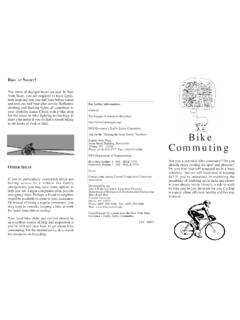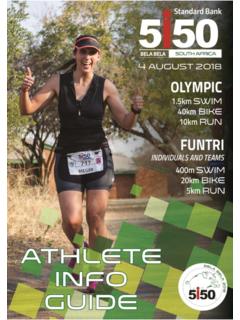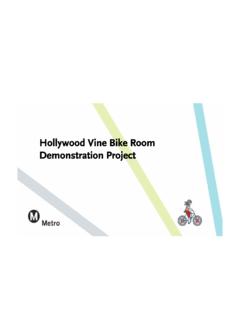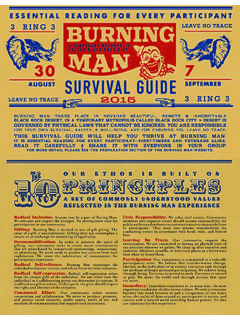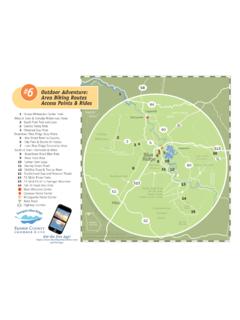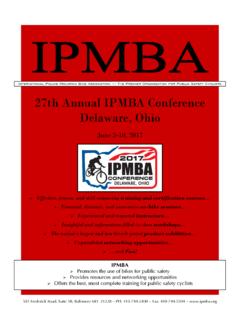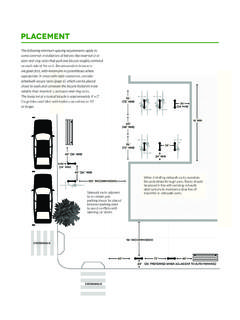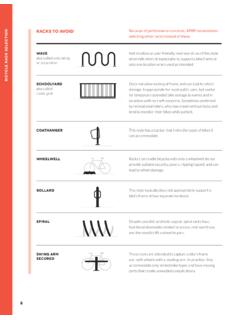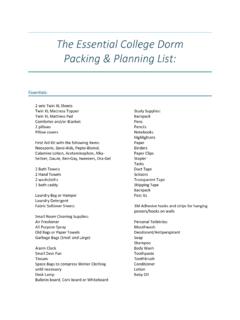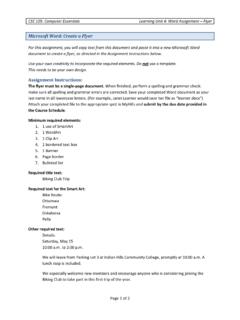Transcription of AN ORGANIZER'S GUIDE TO BICYCLE RODEOS - bike.cornell.edu
1 An ORGANIZER'S GUIDE to BICYCLE RODEOS Acknowledgements Myrah Bridwell diagrams, editing and design; Susie Gwen Criswell illustrations (cover, pg. 14, 25, 27); Kimberly Gabriel- final editing. Thanks to Peter Flucke, President of WE bike , and Jesse Day, Executive Director of the New York Bicycling Coalition and the Dryden Sertoma for their review and input. Funded by a grant from the National Highway Traffic Safety Administration through the New York State Governor's Traffic Safety Committee. While this GUIDE is in the public domain, and may be copied freely, please credit the source whenever you copy or quote any portion of this document.
2 Publication # L-2-19 Version Copyright 2005 by Lois Chaplin BICYCLE RODEOS A GUIDE to Running a Successful BICYCLE Skills Event for Children Introduction A rodeo is a BICYCLE skills event which provides an opportunity for bicyclists to practice and develop skills that will help them to become better bicyclists and avoid typical crashes. Some RODEOS are designed as large, municipal events with skills activities, exhibits and games, while others are much smaller in format, requiring a smaller number of volunteers. An evaluator provides immediate feedback to the participant in a positive manner (satisfactory; needs improvement).
3 If the child has difficulty with a particular lesson, he or she has the chance to keep practicing. The goal of any BICYCLE rodeo is to provide an opportunity for the participants to learn, practice, and demonstrate their BICYCLE handling skills in a fun, noncompetitive atmosphere. Many requests come to me for information about how to run a bike rodeo. On one hand, I'm thrilled that there's a trend away from simply showing a video, handing out a page from a workbook, or teaching hand signals to an assembly hall filled with an entire elementary school. On the other hand, participation in a poorly run rodeo will not do much more to advance the cycling skills of its participants than a matching question on paper will.
4 While it's easy to organize a bad rodeo, it's not as easy as many think to do it right, and effectively. This GUIDE outlines a step-by-step approach to designing a successful BICYCLE rodeo in your community. Parents, members of community service organizations and teachers were in my mind as I wrote this: it's designed to help you show kids in local neighborhoods how to be safer on bikes. We're going to start with a review of the basic principles that an effective program should encompass. The section on how to run a skills event offers guidelines for success. It involves a graduated approach to skills events; starting small and manageable, building upon success.
5 Good luck! Lois Chaplin Extension Associate and BICYCLE Safety Specialist 326 Riley Robb Hall Cornell University Ithaca, NY 14850. (607) 255-2498 (phone). (607) 255- 4080 (fax). 2. Table of Contents Fundamentals of an Effective BICYCLE Education Program ..4. Organizing a Rodeo ..7. Sample Basic Course Diagram ..11. Sample Intermediate Course Diagram ..12. Station One: Registration and Inspection ..13. Station Two: bike and Helmet Fit ..14. Station Three: Starts and Station Four: Scanning ..16. Station Five: Rock Station Six: Demon Driveway ..19. Station Seven: Crazy Crossroads.
6 21. Station Eight: Putting It All Glossary ..24. Rodeo Evaluation ..28. Additional Resources ..29. Bicycling is more than balancing.. 3. Fundamentals of an Effective BICYCLE Education Program ACTIVE LEARNING. Studies have shown that the more involved the learner is, the greater the chance that learning will actually take place. Too many of us have sat passively through a lecture one day, and then been unable to recall much more than the basics the next day. When we are engaged as a learner, we have a much greater chance of succeeding. Bicycling lends itself very well to active, hands-on, experiential learning.
7 League of American Bicyclists Class After School Project RODEOS Classroom Education Brochures Increase in level of preparation (leader) and learning (student). For the sake of comparison, various delivery strategies have been included on this graph. As you progress from left to right, each delivery strategy is more engaging on behalf of both the teacher and the learner. The least amount of active learning occurs when only brochures are handed out (or a video is watched). Classroom activities that address the appropriate traffic concepts are good, but entail a similarly low level of active learning.
8 BICYCLE RODEOS are on- bike activities in controlled environments and involve active learning. After- school programs have an opportunity to include even more active learning, such as on-street bicycling. Courses offered by the League of American Bicyclists (LAB) also offer: 1. training in bike handling skills;. 2. on-street experiences to develop confidence in traffic;. 3. nationally certified instructors. 4. SKILLED INSTRUCTORS. Adults are role models; the best teacher is one who teaches by example. Have you been on your BICYCLE lately? Are you confident with the basic bicycling skills?
9 Many events are initiated by non-cycling adults; that's fine, but it's imperative that skilled cyclists are a part of the program. Your local bike club may be interested in participating. The New York Bicycling Coalition and the League of American Bicyclists can provide a list of skilled cyclists and certified cycling instructors. Many of the skills are easier to teach with someone who can demonstrate. Besides, if you really don't know what you're talking about, the kids will see right through you. Consider developing a program that involves parents and other community adults as participants.
10 By promoting bicycling with youth and adults, you're promoting a great way to get exercise and quality family time. BASED ON CRASH DATA1. An effective program addresses the behaviors that most often result in crashes. By developing the correct behavior, cyclists reduce their chance of being injured or killed. Teach participants the primary BICYCLE handling skills and traffic concepts that will help them to avoid the most common types of crashes. The three big causes of car/ bike crashes for kids are: Riding out of a driveway without stopping Failing to stop for stop signs Suddenly swerving without looking back Other common causes include riding on the wrong side of the street, and riding at night without proper lighting and reflective clothing.
